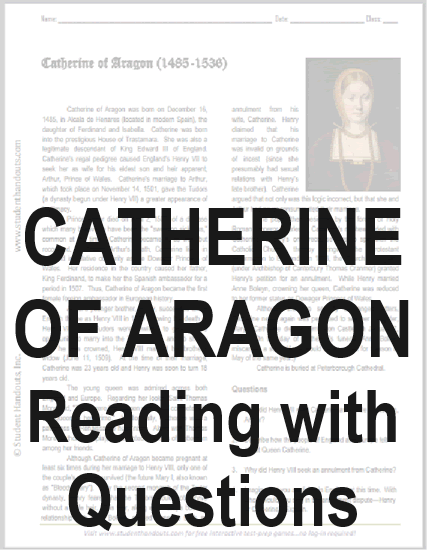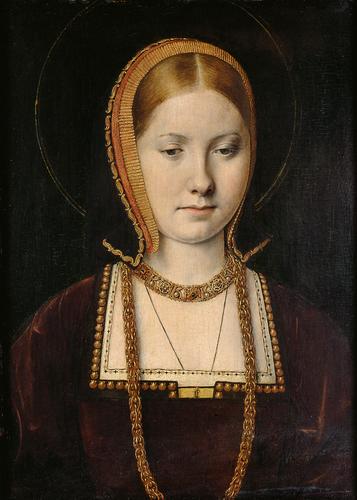| Who was Catherine of Aragon? |
| www.studenthandouts.com > World History > Protestant Reformation |
|
Catherine of Aragon (1485-1536) Catherine of Aragon was born on December 16, 1485, in Alcala de Henares (located in modern Spain), the daughter of Ferdinand and Isabella. Catherine was born into the prestigious House of Trastamara. She was also a legitimate descendant of King Edward III of England. Catherine's regal pedigree caused England's Henry VII to seek her as wife for his eldest son and heir apparent, Arthur, Prince of Wales. Catherine's marriage to Arthur, which took place on November 14, 1501, gave the Tudors (a dynasty begun under Henry VII) a greater appearance of legitimacy. Prince Arthur died on April 2, 1502, of a disease which many believe to have been the "sweating sickness," common at the time. Catherine became ill, as well, but recovered. Following Arthur's death, Catherine lived in England in relative obscurity as the Dowager Princess of Wales. Her residence in the country caused her father, King Ferdinand, to make her the Spanish ambassador for a period in 1507. Thus, Catherine of Aragon became the first female foreign ambassador in European history. |
 |
 |
|---|
Arthur's younger brother, Henry, succeeded to the English throne as Henry VIII in 1509 following the death of Henry VII. The Tudors were unwilling to give up the opportunity to marry into the Trastamaras, and so shortly after he was crowned, Henry VIII married his brother's widow (June 11, 1509). At the time of their marriage, Catherine was 23 years old and Henry was soon to turn 18 years old. The young queen was admired across both England and Europe. Regarding her looks, Saint Thomas More said, "There were few women who could compete with the Queen in her prime." Intellectually, Catherine was a patroness of Renaissance humanism. Along with Thomas More (author of Utopia), she counted Erasmus of Rotterdam among her friends.
The young queen was admired across both England and Europe. Regarding her looks, Saint Thomas More said, "There were few women who could compete with the Queen in her prime." Intellectually, Catherine was a patroness of Renaissance humanism. Along with Thomas More (author of Utopia), she counted Erasmus of Rotterdam among her friends.Although Catherine of Aragon became pregnant at least six times during her marriage to Henry VIII, only one of the couple's children survived (the future Mary I, also known as "Bloody Mary"). Only the second monarch of the Tudor dynasty, Henry feared that the Tudors would not survive without a male heir. This fear, along with Henry's budding relationship with Anne Boleyn, caused Henry to seek an annulment from his wife, Catherine. Henry claimed that his marriage to Catherine was invalid on grounds of incest (since she presumably had sexual relations with Henry's late brother). Catherine argued that not only was this logic incorrect, but that she and Arthur had never consummated their marriage. The pope (then besieged by the forces of Holy Roman Emperor Charles V, Catherine's nephew) sided with Catherine. Henry's only recourse was to split with the Catholic Church, thereby bringing the Protestant Reformation to England. In 1533, the Church of England (under Archbishop of Canterbury Thomas Cranmer) granted Henry's petition for an annulment. While Henry married Anne Boleyn, crowning her queen, Catherine was reduced to her former status as Dowager Princess of Wales. Although the two secretly exchanged letters, Catherine never again was permitted to see her daughter, Mary. Catherine died at Kimbolton Castle on January 7, 1536. On the day of Catherine's funeral, Anne Boleyn miscarried a son. (Anne would be executed for treason in May of the same year.) Catherine is buried at Peterborough Cathedral. The above portrait of Catherine of Aragon was painted by Michael Sittow circa 1503 (when Catherine was around 18 years old). It is housed in the Kunsthistorisches Museum in Vienna, Austria. |
| Click here to print. Click here to view our images in our picture gallery on the House of Tudor. |
| www.studenthandouts.com > World History > Protestant Reformation |









